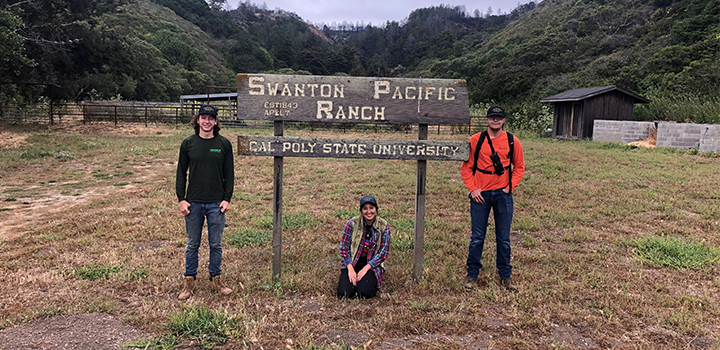Swanton Pacific Ranch: Growing Opportunities

A steady bustle of activity continues at Swanton Pacific Ranch as recovery efforts continue following the August 2020 fire that destroyed much of the ranch’s infrastructure. Specialized contractors continue to remove ash and debris from the ranch, creating a fresh palette for rebuilding.
For the first time in nearly a year, a few students are returning to work full time at the ranch to provide help in recovery efforts. Swanton Pacific, in Santa Cruz County, is managed by Cal Poly's College of College of Agriculture, Food and Environmental Sciences. The paid student positions allow students to gain practical, hands-on experience in post-fire recovery. Raymond Dennis, a fourth-year agricultural and environmental plant sciences major, Pierce Spielman, a third-year environmental earth and soil sciences major, and Sophia Marquez (Environmental Management and Protection, ’21), will spend the summer clearing roads and trails, identifying and removing hazard trees, measuring and removing damaged fences, rehabilitating the apple orchard, and providing administrative support to work through insurance and Federal Emergency Management Agency claims.
 Behind the scenes, a core team of leaders from Swanton Pacific Ranch and the College of Agriculture, Food and Environmental Sciences continue to work with stakeholders to re-envision the ranch’s strategic intent, honoring Al Smith’s vision as a unique Learn by Doing living and learning laboratory for Cal Poly students, dedicated to providing students, faculty, staff and the community with unparalleled learning and research opportunities for understanding sustainable land management practices.
Behind the scenes, a core team of leaders from Swanton Pacific Ranch and the College of Agriculture, Food and Environmental Sciences continue to work with stakeholders to re-envision the ranch’s strategic intent, honoring Al Smith’s vision as a unique Learn by Doing living and learning laboratory for Cal Poly students, dedicated to providing students, faculty, staff and the community with unparalleled learning and research opportunities for understanding sustainable land management practices.
In April, more than 32,000 stakeholders were invited to participate in a survey to help shape that vision. The college also held several open forums and listening sessions with key groups, including faculty and staff, the Swanton-area community, and the Swanton Pacific Ranch Railroad Society. Leaders are now sifting through the nearly 700 survey responses received, which will help shape the strategic intent and inform programming decisions.
The Siegel & Strain Planning and Design Team has been selected after a rigorous search to lead the built-environment rebuilding process, which will be informed by the strategic intent.
“The outpouring of support and commitment from those who have participated directly or indirectly in recovery efforts is astonishing to see,” said Mark Swisher, director of Swanton Pacific Ranch. “It is clear, through my numerous interactions with alumni who have spent time on the ranch in their formative years, that the most important things this ranch is capable of producing are exceptional leaders who value the multiple dimensions of working landscapes.”
Looking forward, a $4.2 million Cal Fire grant was recently awarded to provide increased training for the current and future workforce in fire mitigation, addressing the growing impact of fire in California. Grey Hayes, the ranch’s research and education coordinator, and Jeremy James, head of the Natural Resources Management and Environmental Sciences Department, will lead the effort. In the classroom, students will be taught practical lessons such as designing vegetation management plans to make forests more resilient to fire. Outside of the classroom, a series of workshops, headed by Hayes, will be held throughout California. Students will be involved in that process as well. “Swanton is about the students,” Hayes said. “In every situation that we entertain these conversations of developing community practice, students will be involved. These workshops will allow our students the opportunity to mix with those individuals who will one day be their work peers.”
Visit Cultivate Summer 2021 to read more stories.